This is a Petri Color 35, a compact 35mm point and shoot camera made by Petri Camera K.K. starting in 1968. The Petri Color 35 was the first in a series of Petri Color cameras and is the most desirable as it offers full manual control in a compact and well built chassis. The design of the camera is very similar to that of the Rollei 35, first released in 1966 and although there is no proof that Petri aimed to compete with the Rollei, the strong similarities between the two is not likely an accident. Featuring a collapsible 40mm f/2.8 lens, a lens mounted CdS exposure meter with match needle capability, and bright viewfinder showing focus distances, the Petri Color 35 is an easy to use, compact, and high quality little camera.
Film Type: 135 (35mm)
Lens: 40mm f/2.8 CC Petri coated 4-elements in 3-groups
Focus: 3.5 feet to Infinity with Zone Icons Visible in Viewfinder
Viewfinder: Scale Focus with Projected Frame Lines, Parallax Correction Marks, Distance Scale, and Match Needle
Shutter: Petri “MS” Leaf
Speeds: B, 1/15 – 1/250 seconds
Exposure Meter: Coupled CdS Cell w/ viewfinder match needle
Battery: 1.35v PX675 Mercury Battery
Flash Mount: Hot Shoe and M and X Flash Sync, All Speed X-sync
Other Features: Battery Check Button, Automatic Resetting Exposure Counter, Shutter Lock When Lens Collapsed
Weight: 396 grams
Manual: https://www.cameramanuals.org/petri_pdf/petri_color_35.pdf
Manual (Japanese): https://mikeeckman.com/wp-content/uploads/2022/03/PetriColor35ManualJapanese.pdf
Repair Manual: https://mikeeckman.com/media/PetriColor35RepairManual.pdf
How these ratings work |
The Petri Color 35 was created to compete directly with the Rollei 35, and this comparison has stuck with it throughout it’s entire existed. For camera that cost significantly less both when it first came out and today, it offers some very useful ergonomic and functional improvements, while growing in size by only a very small amount. Optically, the camera doesn’t compare to the Rollei, but with it’s other improvements and significantly lower cost, the Petri Color 35 is still a very good camera that any collector/user should consider. | ||||||
| Images | Handling | Features | Viewfinder | Feel & Beauty | History | Age | |
| 1 | 2 | 1 | 2 | 2 | 1 | 20% | |
| Bonus | +1 for complete package, this is a terrific camera that adds up to more than the sum of it’s parts | ||||||
| Final Score | 11.8 | ||||||
History
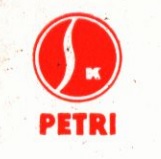 Ask any collector about a Petri camera, and assuming they’re aware of the brand, the type of answer you get will vary wildly based on which specific model you are referring to. Petri, originally known as Kuribayashi was one of Japan’s oldest optics companies, dating it’s history back to a small workshop founded in 1907 by Kuribayashi Yōji producing a number of photographic accessories for Japan’s early photography market.
Ask any collector about a Petri camera, and assuming they’re aware of the brand, the type of answer you get will vary wildly based on which specific model you are referring to. Petri, originally known as Kuribayashi was one of Japan’s oldest optics companies, dating it’s history back to a small workshop founded in 1907 by Kuribayashi Yōji producing a number of photographic accessories for Japan’s early photography market.
In the 1920s, Kuribayashi, like many early Japanese optics companies, started producing cameras, many of which were sold “white label” without any identifying marks, making identifying early Kuribayashi cameras difficult.
It wouldn’t be until after the war when Kuribayashi reorganized itself into an all new company officially called K.K. Kuribayashi Shashin Kikai Seisakusho and relocated to Tokyo, did the company’s products become recognizable.

Like many Japanese optics companies at the time, Kuribayashi produced a large number of good, but unremarkable medium format folding cameras. Most were of the “semi” type like the Karoron, shooting 4.5cm x 6cm images on 120 roll film. Kuribayahi’s first 35mm rangefinder was released in 1954 and was called the Petri 35. It was a fairly modest model featuring a 45mm f/2.8 Orikkor lens and a simple shutter with a top speed of 1/200. The camera didn’t stay simple for long however, as the company continually evolved the model, improving the design with more features, faster lenses, and better shutters.
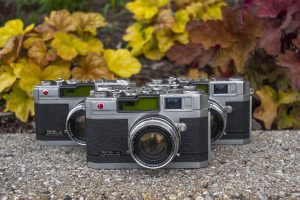
Later models like the Petri Automate and an endless supply of similar Petri 1.8, 2.0, and a whole series of “Color Corrected Super” models would be released over the next decade or so. The company would even venture into the world of the 35mm single reflex cameras with their release of the Petri Penta in 1959, featuring the M42 universal lens mount and a line of excellent Petri Orikkor lenses.
In 1962, as was customary with many Japanese optics companies of the era, Kuribayshi would change it’s name to that of it’s most successful product and become Petri Camera K.K., or simply, Petri. As Petri, the company continued to offer both 35mm rangefinder and SLR cameras at the same time, however the company’s target customer increasingly went towards the economic end of the scale. Where earlier Kuribayashi/Petri cameras were solidly built, by the mid 1960s, Petri’s reputation was largely as a budget camera maker as they could not compete with other A-list Japanese makers like Nippon Kogaku and Canon.
Over the next couple of years, Petri’s offerings seemed to stagnate, with minor revisions to the same basic rangefinder and SLR models, but in 1968, the company made a bold attempt to compete with a camera in a segment, they never were in before, the premium compact point and shoot segment.
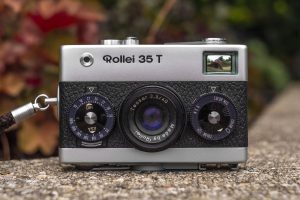
Perhaps calling this a segment is a bit misleading as at the time, there was really only one camera to compete with, the Rollei 35, which made it’s debut in 1966. The Rollei 35 was a very innovative camera designed by Heinz Waaske while still employed by Wirgin. The original design of Waaske’s unnamed camera was so far fetched that when presented to his boss, Heinrich Wirgin became angry that Waaske used the company’s resources to work on an unauthorized design. This soured the relationship between Waaske and Wirgin, which eventually led to Waaske’s departure from the company.
While searching for a new job, Waaske demonstrated his new camera to Kodak and Leitz, who also showed no interest in such a compact camera. It was not until after gaining employment by Franke & Heidecke, the makers of the Rolleiflex, did the company agree to produce the camera.
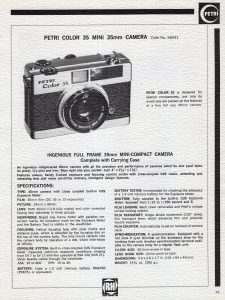
The Rollei 35 was an immediate success. It’s ultra-compact size and excellent lens, while still being able to produce full 24mm x 36mm images drew the attention of many pros, looking for a small companion to their larger SLR cameras.
While the Rollei 35 appealed to many people, it’s initial retail price of $189.50, which when adjusted for inflation, compares to about $1500 today, put it out of reach of all but the most serious photographers. Apparently, someone at Petri saw this as an opportunity to create something with most of the same features and similar size of the Rollei 35 and sell it for a much lower cost.
In my research for this article, I found no information about the development of the Petri Color 35. There were no names of designers, or anyone at Petri who took up the cause for competing with Rollei, no information about prototypes, or possible other versions of this camera that would eventually come later.
When it was released, Petri wisely promoted the camera’s small size heavily. In the three ads below, the camera is seen next to a sheet of US postage stamps, a packet of Kleenex tissues, and in the third one, referred to as a “midget”. When first released, the camera carried a retail price of $99.50, but the ads below from a year after it’s release say the price is “under $110” suggesting it had a $10 price increase a year later. Regardless of $100 or $110, the camera was still nearly half that of the Rollei 35, offering a significant discount for a camera that compared very favorably.
The photographic press was rightfully excited about the prospect of a lower cost Japanese competitor to the popular Rollei 35. Comparisons between the two models came right away, as the short article from the August 1968 issue of Modern Photography below gives a high level overview of the Petri.
More reviews for the Petri Color 35 from the April 1969 issues of Modern Photography and Camera 35 are listed below. In each case, the reviewers came away with positive comments for the compact size, excellent ergonomics, and good images produced by the camera.
Most Petri Color 35s came with a chrome body, but a small number were painted black. These black cameras are highly sought after today as they’re really hard to find. Even more difficult though is a rare variant called the Petri Color 35 D. This model, with a unique black bezel and large letter “D” to the right of the viewfinder window is often referred to as the Deluxe model. Some versions of the D have the letter painted D, but most I’ve seen are black.
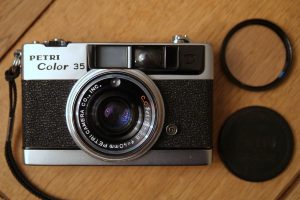
Besides the bezel however, the only difference between the D and non-D models is a revised top speed of 1/300 compared to 1/250 in the regular model. The number 300 on the shutter speed dial is usually in yellow on these cameras as well, but otherwise show no differences.
Although I do not read Japanese, looking back and forth for any differences between Japanese language versions of the Petri Color 35 and Color 35 D manuals, I saw no other differences other than the speed. A difference between 1/250 and 1/300 amounts to a difference is 1/5th of a stop and would make such a little difference, I cannot imagine why this was done, other than perhaps a different supplier for the shutter.
In the year after the Petri Color 35’s release, the camera had a lot going right for it. It had a feature set that compared favorably with the Rollei 35, it offered some ergonomic improvements, it sold for a considerable discount, and magazine reviews for the camera were all positive, yet with the benefit of hindsight, the camera was only produced for a short time.
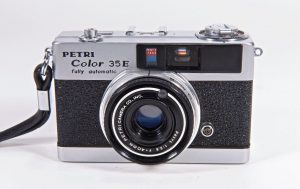
In 1971, a similarly sized, but functionally very different camera called the Petri Color 35E was released. The Petri Color 35E had the same 40mm f/2.8 body, but added programmed auto exposure with no option for manual exposure. Gone were the clever shutter speed and aperture dials on the top plate. Also missing was the focus wheel that also extended the lens. The new model had a simpler “push/pull” collapsible lens with front cell focus and a simpler viewfinder.
It seems that Petri’s role as a lower end maker of economic cameras killed any desire for the company to keep the original model in production. While I have no evidence of this, it was probably deemed more cost effective to make these simpler cameras and sell them as fully automatic point and shoot cameras, rather than anyone looking for a competitor to the Rollei 35.
As the 1970s progressed, Petri’s reputation for poor quality control grew. Cheaper and simpler models became the norm for the company with a large number of Petri made models rebranded for other companies. The company would limp to the end of the decade and eventually cease producing their own cameras, ending their run as one of Japan’s oldest optics companies.
Today, mention the name Petri to any collector and you’ll likely get some form of “stink eye”. As I started off this review saying people’s opinions of the brand vary wildly depending on which model you’re referring to, but I think it’s safe to say that the Petri Color 35 is grouped in with the company’s earlier models which were well built and capable of wonderful results. That’s not to say the Color 35 is perfect, but it offers a compelling option for those looking for the smallest possible 35mm full frame camera with a good lens, and full manual control.
My Thoughts
The first time I handled a Rollei 35 was several years ago at Central Camera in Chicago, Illinois. The camera was in excellent shape and had previously been serviced. Being for sale at a very popular camera shop, it also came with a very high price tag. Not familiar with the camera’s controls, and fearful of the massive dent it would put in my wallet if I broke it, I cautiously handed it back to the salesperson and moved on.
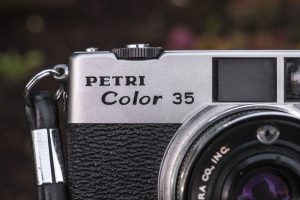
The damage was done however, and I began what would end up being a two year quest towards owning my own Rollei 35. In the summer of 2020, I finally found an example in good enough shape for the right price and happily picked it up. In the time since, the Rollei 35 has become one of my favorite “zoo cameras”, which is a term I invented to mean something small and unobtrusive, but also quick to use and capable of excellent shots when taking the kids to the zoo. Large cameras with complicated controls are not good when juggling around Radio Flyer wagons and backpacks filled with juice boxes, pretzels, and sanitary wipes while chasing around small children, so I value cameras like the Rollei 35 for those adventures.
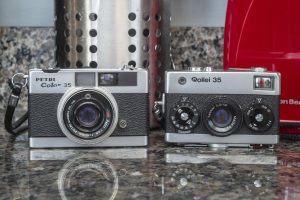
When I learned of a Petri camera that came out around the same time as the Rollei 35, with a nearly identical size, but reportedly simpler controls, I knew I had to get my hands on one. There’s a saying that “when it rains, it pours”, and in a very short period of time, I found myself in possession of not one, not two, but three Petri Color 35s. None were perfect, but it gave me the opportunity to pick the best one, and that was the one I kept, selling off the other two.
Now with both the Rollei 35 and Petri Color 35 side by side, it becomes apparent that while the Petri is small, it’s still a bit larger than the Rollei, most significantly in width, which it exceeds by about 3mm. Depth and height are about the same, with the Petri also being heavier at 396 grams versus 364 grams for the Rollei.
Although similar in dimensions, the two cameras differ in quite a number of ways, some more significant than others. I’ll cover these throughout this section as I walk through the camera’s various controls.
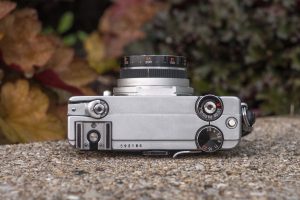
Up top, the Petri Color 35 shows the most significant differences from the Rollei. On the left we see the flash hot shoe and folding rewind knob, both of which appear on the bottom of the Rollei. While the location of a rewind knob isn’t that big of a deal, having the flash in a more usual condition up top is quite a bit more elegant that mounting it on the bottom of the camera.
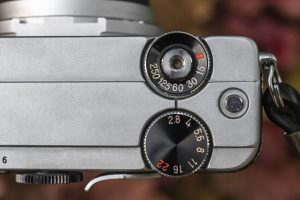
On the right side are two black dials for shutter speeds near the front and f/stops near the back. Both dials overlap the front and rear edges of the top plate, making them very easy to turn by sliding your finger across the knurled edges of both dials. The shutter speed dial up front has click stops at each indicated speed plus bulb. Intermediate speeds are not possible. The aperture dial does not have click stops and does allow for intermediate selections allowing for smooth and precise control of exposure. A cable threaded shutter release button is in the center of the shutter speed dial and is comfortably located within easy reach of the photographer’s right index finger. Finally, a small chrome battery test button is off to the far right.

Flip the camera over and the Petri Color 35 is much like any other camera with a rewind release button, 1/4″ tripod socket, and release lock for the film compartment. This is contrary to the Rollei 35’s unusually busy bottom plate.

The back of the camera differs quite a bit from the Rollei too, having the automatic resetting exposure counter in the upper left corner, with the rectangular eyepiece for the viewfinder close towards the center of the camera.
Next to the viewfinder is a round focus wheel for the camera’s lens. This focusing wheel is also what’s used to extend the lens into taking position. Like the Rollei, the Petri Color 35 has a collapsible lens, but rather than having to press a release button and manually push the lens back in the body, with the Petri, simply rotate this wheel counterclockwise all the way and the lens collapses. To extend it, turn it clockwise until the lens reaches the infinity position. Also like the Rollei, the lens must already be extended before you can press the shutter release, however there is no requirement to cock the shutter before collapsing the lens.
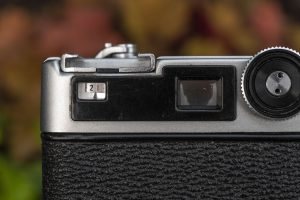
The last thing to see on the back is the film advance lever, which sticks out of the back of the camera and comfortably works with the photographer’s right thumb, as opposed to the Rollei which is controlled with the left thumb.
Remove the back of the camera to reveal the film compartment. Both the Rollei and Petri cameras have a hinged film pressure plate that folds along the bottom edge over the film gate. Film loads in the Petri Color 35 from left to right, unlike the Rollei which is right to left. Both cameras have a fixed and multi-slotted take up spool. The Rollei is a bit more elegant with painted arrows indicating film direction, but in use are both equally easy to use. Both cameras also have deep channels along the door edges without any foam light seals, so light leaks shouldn’t be an issue with either camera.
Both the Rollei and Petri cameras have the battery compartment unfortunately located within the film chamber. With the Rollei, it’s tucked above the location for the supply cassette of film, and on the Petri, it’s on the bottom of the film gate. The Rollei uses a PX625 mercury battery and the Petri a PX675 mercury battery. To my knowledge, the Rollei does not have a bridge circuit, so using a 1.5v silver oxide or alkaline battery will throw off the meter readings. I am unsure if the Petri has one, but my best guess would be it does not, so using the meter on both cameras would be problematic without something like a Wein cell, or having the camera modified to alter the voltage.

Up front, the Rollei has all of it’s exposure controls on the face of the camera, compared to the Petri which are on top. Around the perimeter of the Petri’s lens is an ASA film speed scale with a black rubber ring closer to the body, allowing you to calibrate the meter with film speeds from ASA 25 to 800. The opening for the Petri’s CdS exposure meter is within the filter ring of the lens, which allows the meter to automatically compensate when color filters are used. This, compared to the body mounted meter of the Rollei 35 requires you to manually compensate for filters.
One thing that is unfortunately missing from the Petri Color 35 however, is any sort of external focus scale. From the outside of the camera, you have no idea what distance the lens is set to, making zone focusing a bit of a challenge.
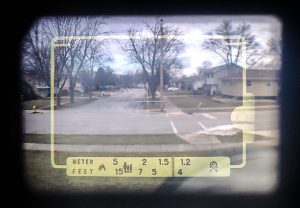
The only place you can see focus distance is within the viewfinder, which thankfully is large and bright. The Rollei’s viewfinder is slightly larger and benefits from less magnification, but in both cases, I had no problems seeing the projected frame lines while wearing prescription glasses. The Rollei’s viewfinder has just the frame lines, and nothing else, whereas the Petri has the frame lines, a large plus in the center of the image which helps orient the camera on the horizontal and vertical horizon, and a clever focus scale at the bottom. While I do appreciate being able to see the lens focus distance within the viewfinder, it is a shame this isn’t anywhere on the outside of the camera. Further confusing things more, is that infinity is indicated by a set of mountains and feels a bit vague to it’s location. While depth of field should easily take care of any minor variance, I would have preferred a more precise way of measuring focus distance.
Finally, off to the right of the viewfinder is the match needle for the exposure needle. A red circle and black needle are used to indicate proper, over, and under exposure. This works similarly to other match needle cameras. Compared to the Rollei whose meter read out is only visible on the top plate, I much prefer seeing it in the viewfinder.

If you were in the market for the smallest possible full frame 35mm camera in 1969 and had to choose between the Rollei 35 and Petri Color 35, the minor differences in size and weight likely would have no effect on your decision, but the arrangement of controls would definitely favor the Petri. With the left handed film transport, upside down locations of the flash shoe, exposure counter, rewind knob, front facing exposure controls, and complicated process of extended and retracting of the lens, the Rollei 35 likely would have been a tougher sell. Combined with a significantly lower price tag, the Petri Color 35 seems like a winner. But of course the Rollei was produced for multiple decades whereas the Petri was only made for a little over a year, so what went wrong?
Repairs
I was fortunate enough to find three different Petri Color 35s all at once. I picked the best looking and functioning one, so it didn’t need any repairs. Thankfully I didn’t need to open it up, but had I needed to, perhaps this repair manual would have been useful.
If you would like to try and take apart your Petri Color 35, here is that repair manual.
https://mikeeckman.com/media/PetriColor35RepairManual.pdf
My Results
Suspecting I would either really like the Petri Color 35, or find it fundamentally flawed, I wanted to shoot more than a single roll of film through it, so over the course of the last few months of 2021, I carried the Petri along with me, first with a roll of ORWO NP20 and then later with a lightly expired roll of Kodak Portra 400. Since the target customer of this camera would have used it as an everyday point and shoot, I kept it in the glove box of my car, pulling it out to shoot random things around where I live.
After shooting and developing two rolls, I started to have some pretty strong impressions of the Petri Color 35. Before I get to those however, first, let’s look at the images.

In Modern Photography’s April 1969 test of the Petri Color 35 which I’ve shared above, the magazine rated both the center and edge sharpness of the Petri 40mm f/2.8 lens from Good to Acceptable at all f/stops, and quite honestly, I agree with their assessment.
To be clear, the images above from the two rolls of film I got were definitely good. There wasn’t a single image where I thought “Gee, this looks terrible”. In most images, the center sharpness was as I expected, and although there was some softness and very mild vignetting near the corners, it wasn’t anything that I think someone in 1969 looking for a sub $100 point and shoot camera would have been unhappy with.
Comparing these images to those I got from my Rollei 35 with the Zeiss Tessar 3.5 however, they definitely lacked the “pop” I noticed with those images.
Using the camera was quite pleasant. The slightly larger size than the Rollei didn’t bother me a bit as I could only detect a difference when holding the two cameras side by side. The larger size of the Petri afforded it some ergonomic improvements. I felt the location of the shutter release to be perfect, and I very much liked how the shutter speed and aperture wheels worked. Both can be easily controlled by sliding your right thumb or forefinger across the rear or front edges of the camera.
The click-stop-less design of the aperture wheel was a good idea. Although this camera lacks any sort of auto exposure, I used it sort of like a shutter priority auto exposure in which I set the shutter speed to a single speed and left it there, rarely changing it unless my lighting dramatically changed. For exposure, I kept my eye on the exposure meter and spun the aperture wheel until the needle was in the circle. Although this camera was designed for 1.35v mercury batteries, using a 1.5v alkaline battery did not seem to throw off the meter’s accuracy. I am unsure if the Petri has a bridge circuit to compensate for the voltage difference, or if I was just lucky, but to my eye, the images all look properly exposed.
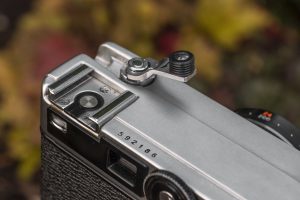
I loved the viewfinder. It was bright and easy to use, and although it lacked a rangefinder, this was actually a good thing as the lack of a beamsplitter meant that nearly all the light that entered from the front would pass through to my eye, assuring an image as bright as possible. Focusing was easy too, as the depth of field afforded by the semi-wide 40mm lens allowed me to guess focus with relative ease. Finally, having the focusing scale visible at all times was quite handy. With most scale focus cameras, you need to keep lowering the camera from your eye, choose your distance, then bring it back up. With the Petri, seeing the chosen distance at all times in the viewfinder meant I could handle changes in scenery much faster than I otherwise could.
Another benefit to the Petri Color 35’s design is the simplicity of extending and retracting the lens. When you are done shooting the camera, simply rotate the focus wheel until the lens fully retracts the lens. This not only prepares the camera for storage, but also locks the shutter release, preventing any accidental exposures while not in use. Although slower than the Rollei’s “pull and twist” method, the Petri’s is easier and more straightforward as there is no requirement to first wind the film advance lever before retracting the lens. This unorthodox requirement of the Rollei often throws new users of those cameras off, and can actually cause damage to the shutter when handled by someone not familiar with how it works.
Of course, the Rollei has a much more advanced shutter with a wider range of shutter speeds. The limitation of 1/15 to 1/250 on the Petri is certainly less flexible, but back to how I used this camera where I largely kept the shutter speed at a single speed, this was not a problem for me.
I find the lack of any focus distance markings or depth of field scale on the outside of the camera to be a big miss for the Petri, but as long as you keep the camera to your eye, you really don’t need it. Also, while I understand it was done in the interest of keeping the camera as compact as possible, having the battery inside the film compartment is just as inconvenient as it is on the Rollei.
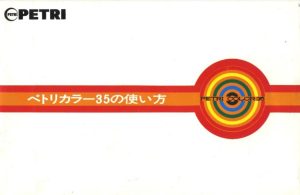
Overall, I felt the design, ergonomics, and viewfinder of the Petri Color 35 was superior to the Rollei. In terms of build quality, they both seem similar, with the one exception being inside the film compartment where the Petri is a bit sloppy. The most significant area where the Rollei wins however, is in it’s lens. Despite both cameras having 4-element 40mm designs, the Rollei’s Zeiss optics are clearly superior to the Petri’s. I’ve only ever shot Tessar Rollei 35s and loved those images, but they also had an even better option with a Sonnar.
Of course, when these cameras were new, the Petri was close to half the cost of the Rollei, and looking at eBay prices today, there is still a huge price disparity between the two. As I write this, sold prices of Petri Color 35s, range from $35 – $100 compared with $115 to over $300 for Rollei 35s with the Tessar lens. Versions with the Sonnar, or other special edition versions can go much higher than that!
I really enjoyed my time with the Petri Color 35. While the camera is not perfect, as a compact fully featured 35mm point and shoot, it is easy to use with great ergonomics. The lens doesn’t reach the level of sharpness as the camera’s primary competitor, but for the price you’re likely to pay for a working copy, I still feel comfortable recommending the Petri to anyone interested in the smallest possible full frame 35mm camera without breaking the budget.
Related Posts You Might Enjoy
External Links
http://camera-wiki.org/wiki/Petri_Color_35
https://www.cameraquest.com/petri35.htm
https://www.35mmc.com/05/09/2015/petri-color-35-review/
https://filmosaur.wordpress.com/2018/04/13/meet-the-camera-petri-color-35/
https://www.photo.net/discuss/threads/not-quite-a-masterpiece-the-petri-color-35.487072/
http://www.collection-appareils.fr/x/html/page_standard.php?id_appareil=243

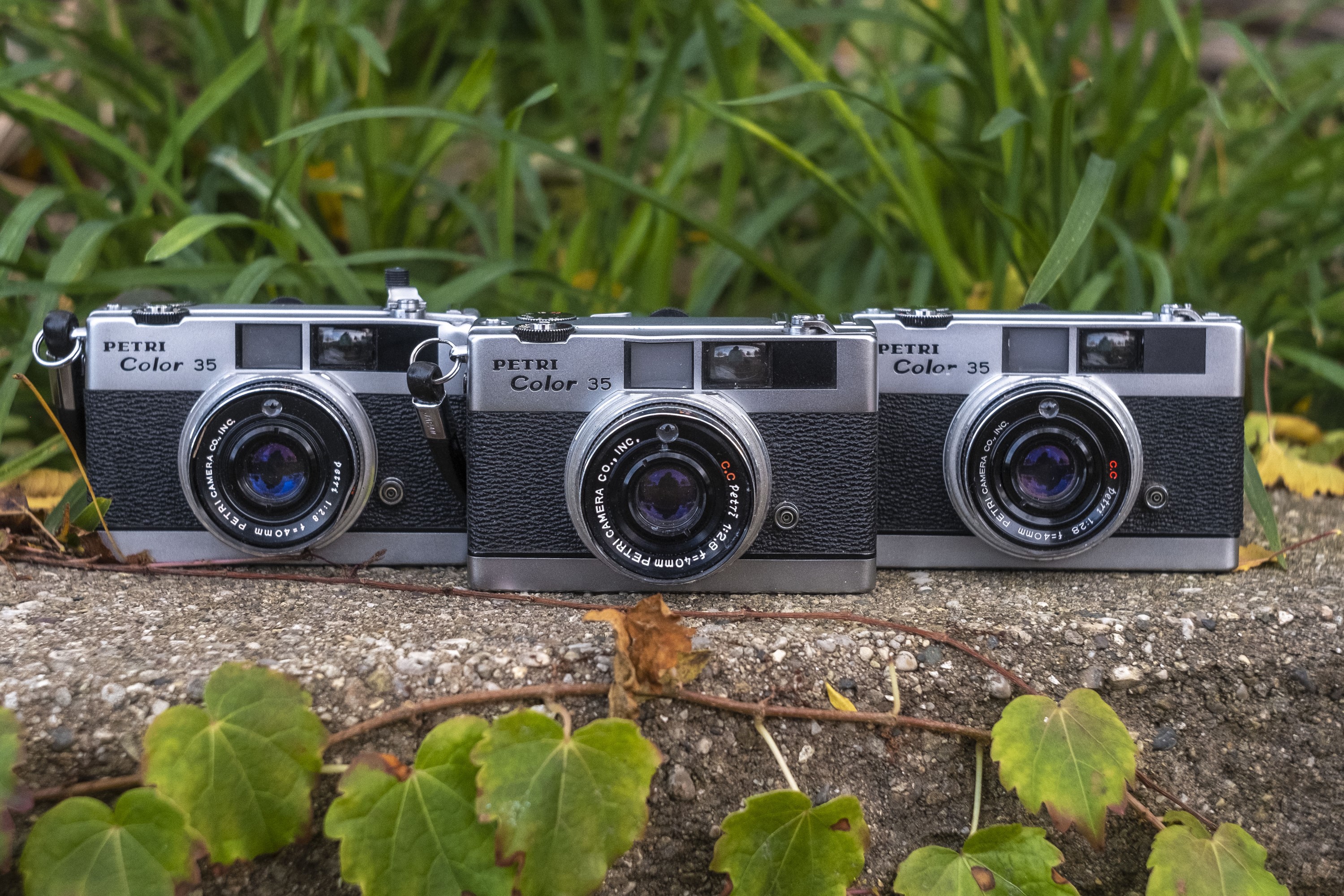
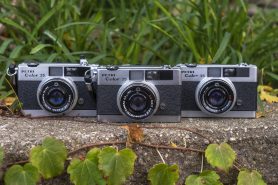
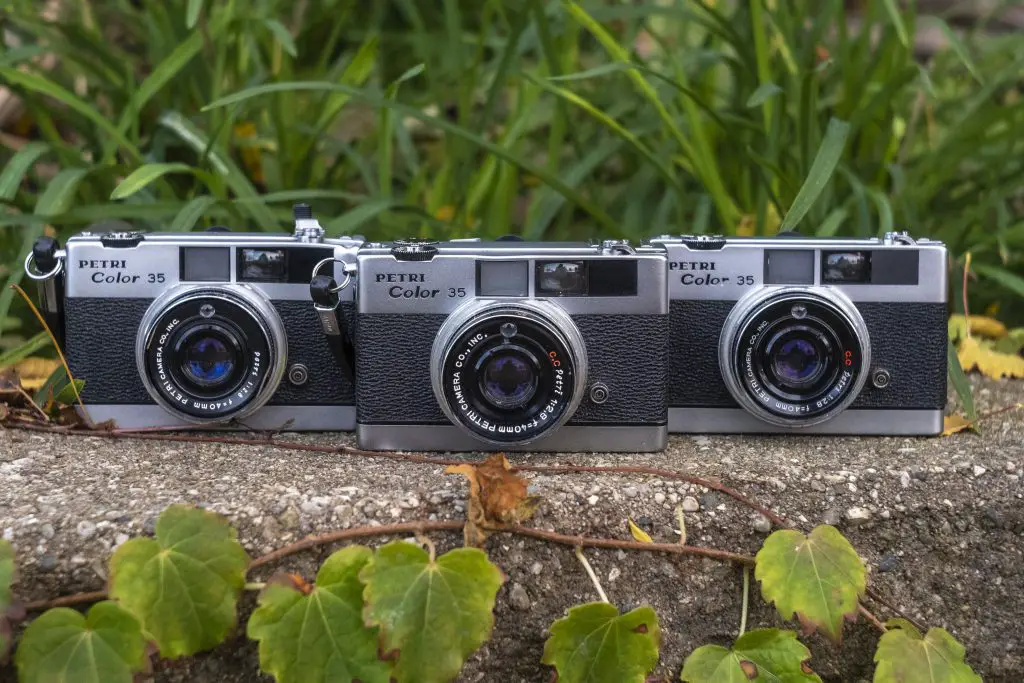
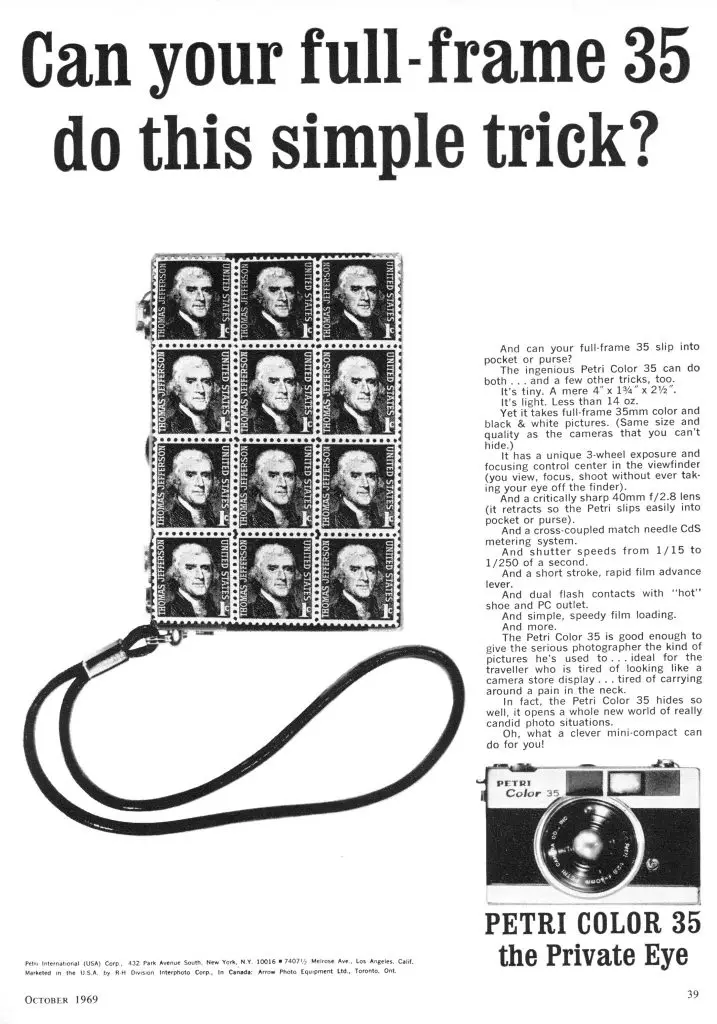
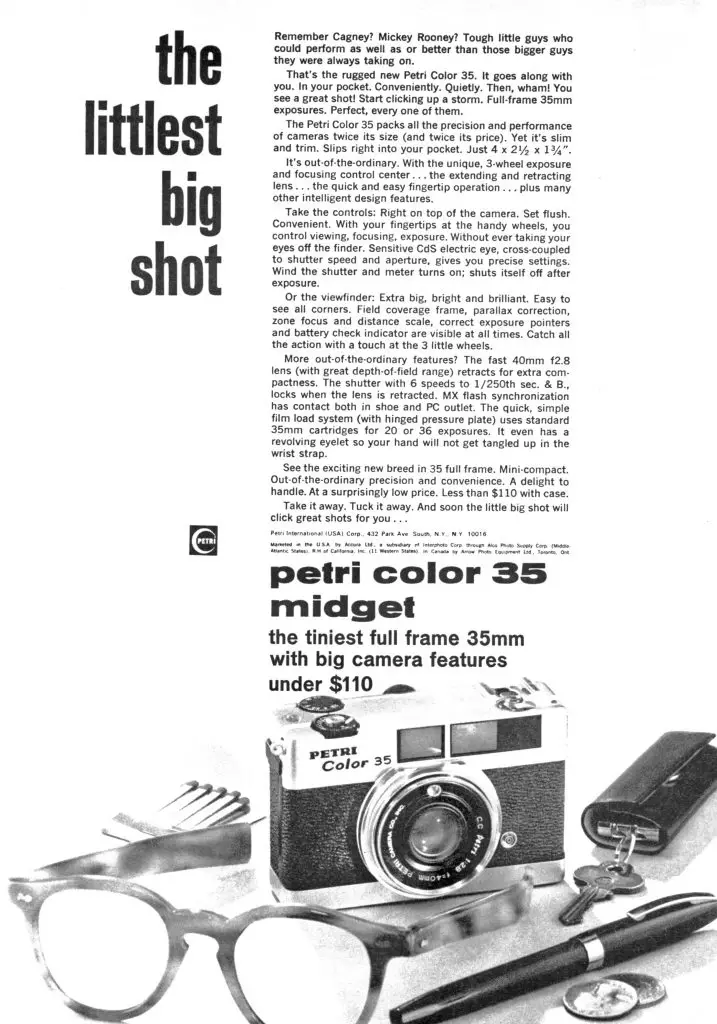
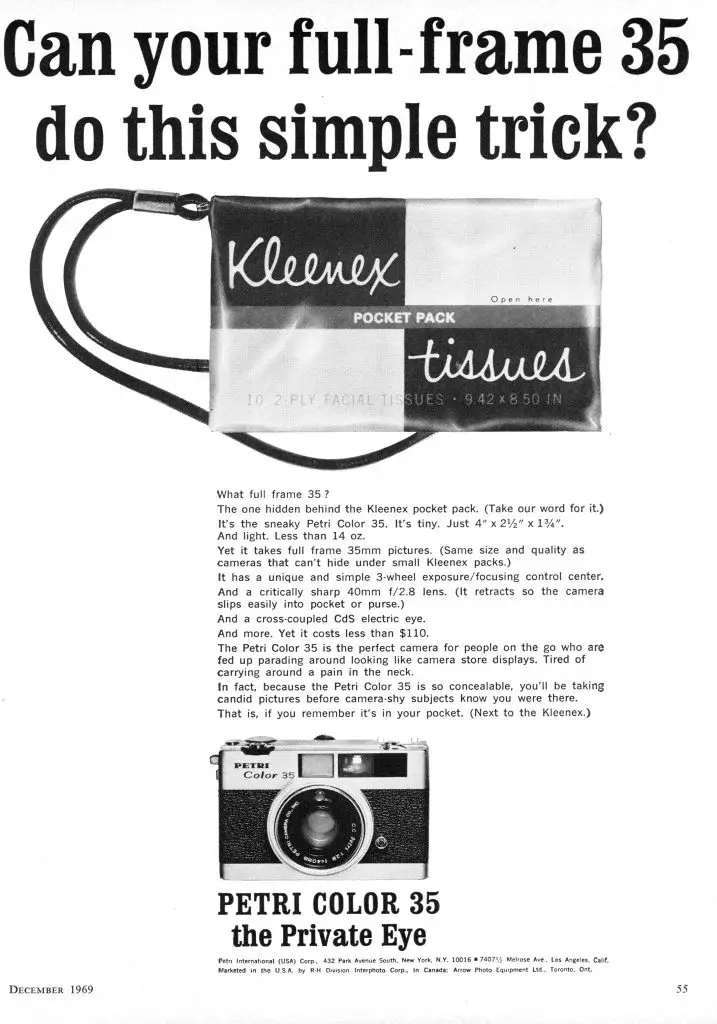
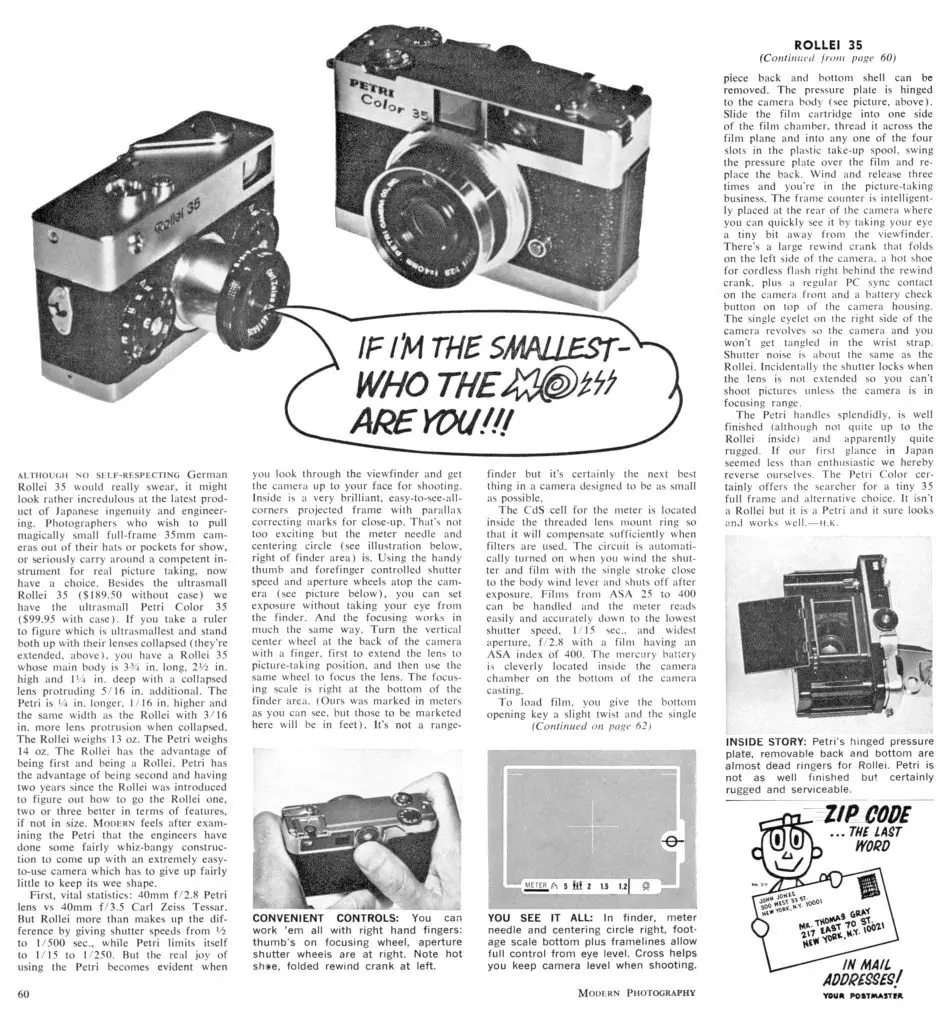
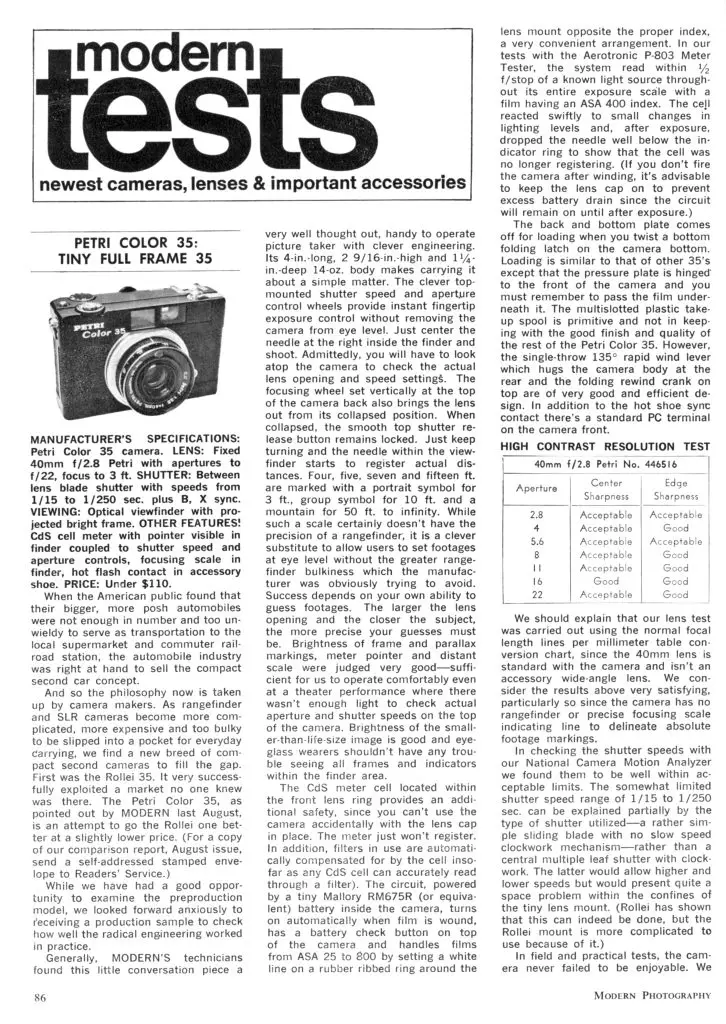

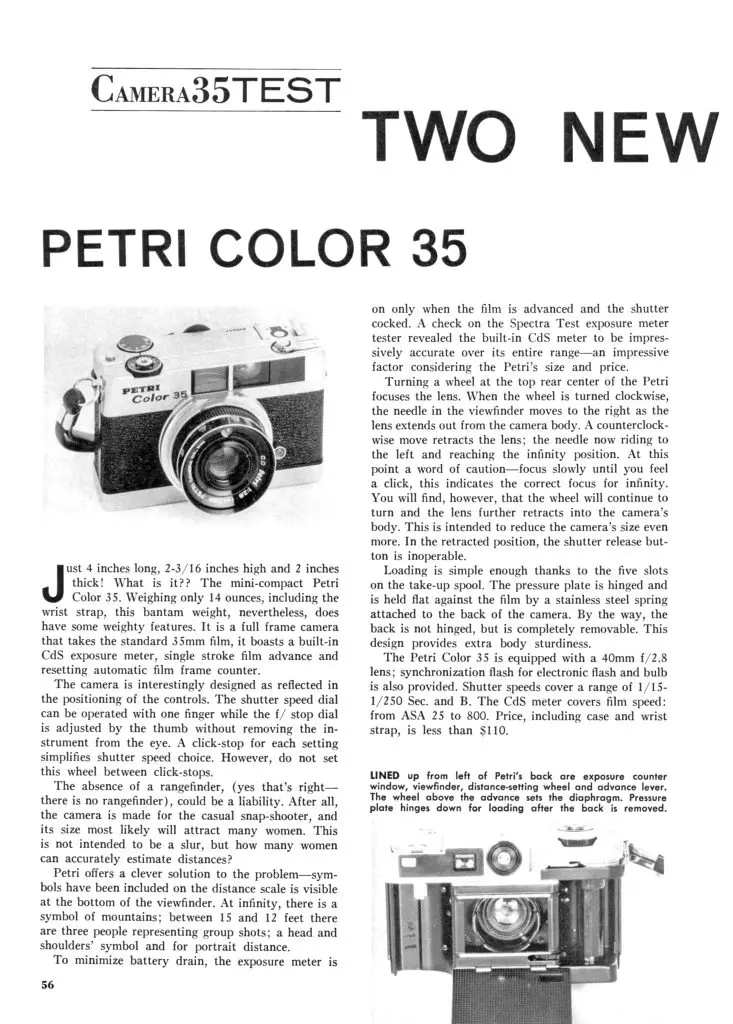
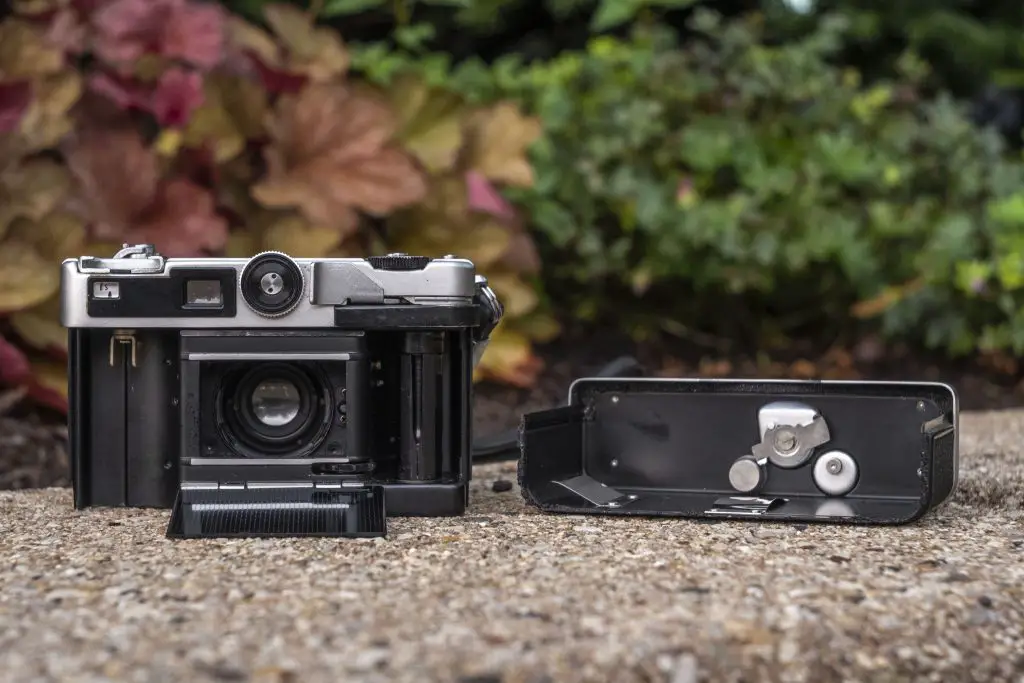
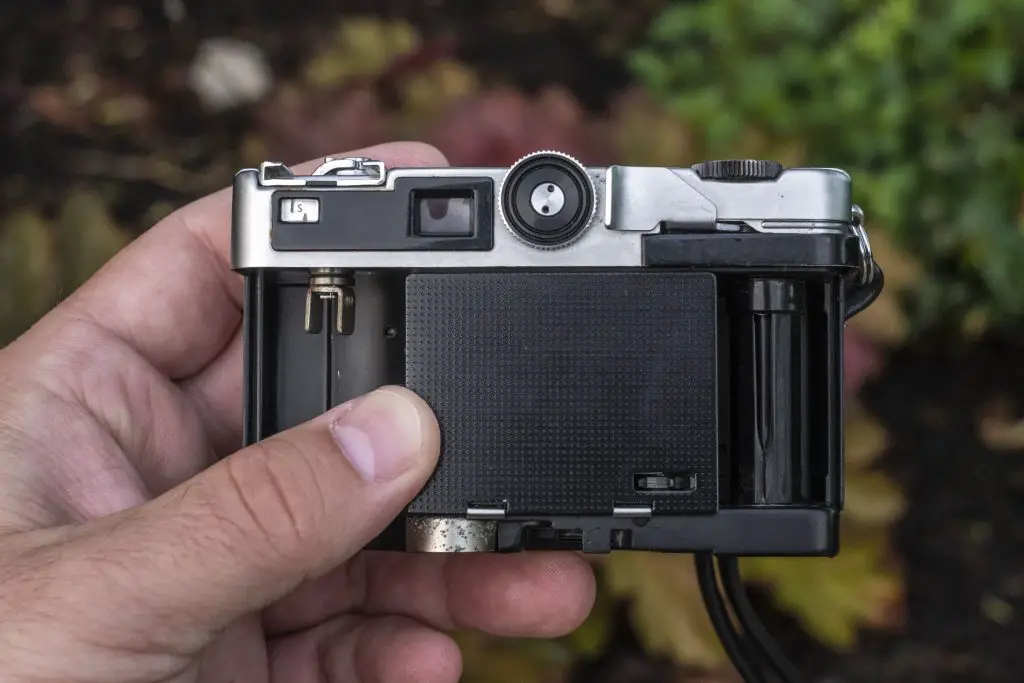
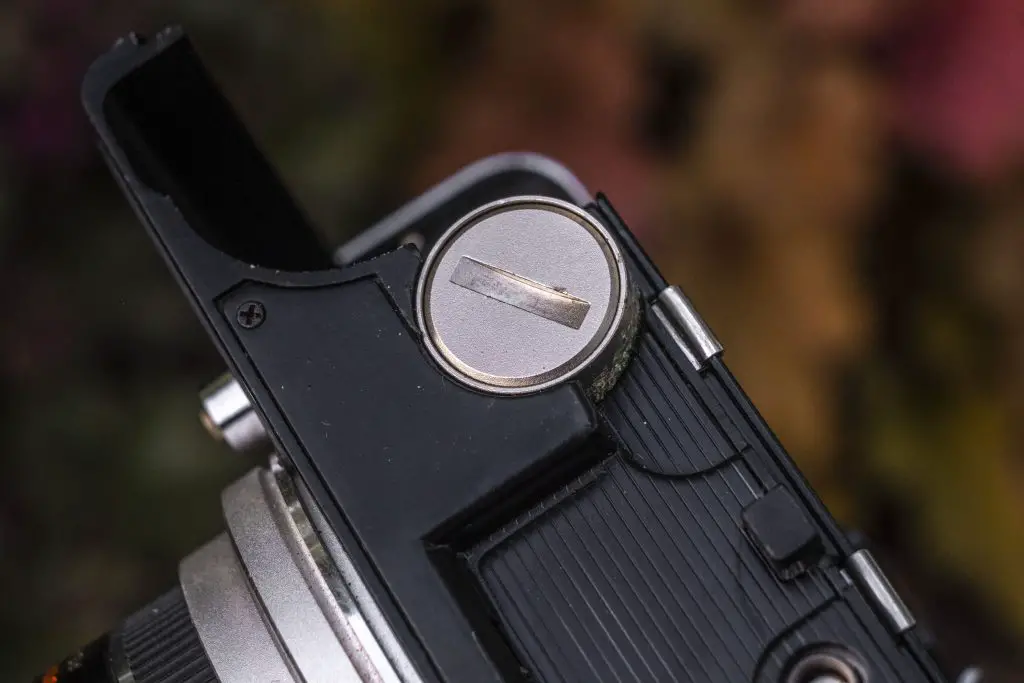
























Mike sez, “I picked the best looking and functional one” (of three cameras) – the stress being on functional. That pretty well sums up my experience with all things Petri. Some excellent lenses – including a few that are cult favorites due to their near-IR wavelength transmission – but consistently poor construction. Petris were clearly not built for durability. An SRT-100 or Nikomat or Canonet, bought at random, are more likely to still be functional. My opinion, yes, but based on a few decades’ experience.
The Petri Micro Compact I’ve owned for thirty years says different. I’ve collected many old cameras over the years and found many big name models with serious issues and notably poorer construction, but the Petri – which I bought to use, not as a collector piece – is still faultless and in perfect working condition three decades later. And my Micro Compact is only a cut-down, much cheaper version of the already budget-friendly Color 35.
I had a black Petri Color 35 as my main personal camera from 1970 (when I was 15) to 1983, and I took hundreds of great shots with it.
My parents were pros (mainly doing 4×5 b/w), and I could borrow a Nikkormat or F2 whenever I wanted to… but unless I needed to use a longer or wider lens for something specific, I rarely did. I carried the Color 35 on my belt (my mom sewed a couple of leather strips onto its camera case) in all kinds of situations where a larger camera would have required more preplanning and/or been a chore to carry. While the Color 35’s lens obviously doesn’t really compare to the awesome German glass on the Rollei 35, these cameras are still great little shooters!
Just last year I picked up another 60s Petri 35mm camera – a 7s rangefinder (45/2.8 version) – at a local flea market for twenty bucks. Turns out that it works perfectly (even the Selenium meter!) Though I have no plans to really use it – I mostly shoot film with my 60s/70s Nikon and Olympus equipment these days – it feels good to have another Petri in the collection.
Good review. The Color 35’s could have achieved greatness but didn’t quite make the grade. I enjoyed the one I had even with it’s flaws but not enough to keep it. Keep up the good work.
I have a chrome (D version ) i love it .local dealer wants it. !! no way .good reviews.